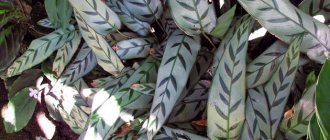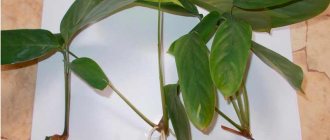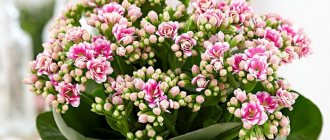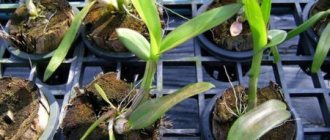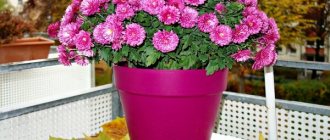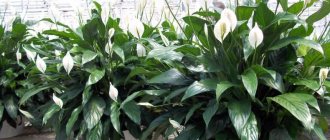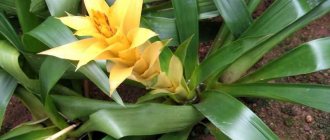Calathea Varshevich attracts flower growers with its unusual appearance. This luxurious plant can decorate any apartment or office space.
The leaves of the crop are unusual dark green in color with a light green pattern on the surface . When darkness comes, the plant lifts its leaves and closes for the night.
Maranta calathea Varshevich description and characteristics
Calathea is a perennial crop with a short stem. The leaves are large, long-petiolate, collected in a rosette, located in the lower part of the shoot . Depending on the growing conditions, the leaf length ranges from 15 to 50 centimeters. The plates are simple, oval in shape with a wavy velvety surface.
A clear pattern is visible at the top of the sheet. Thick light stripes with jagged edges are well defined against the overall dark green background. The attractive design resembles a Christmas tree. The inner surface of the leaves has a beautiful brown-burgundy color. The petioles have the same color.
The culture is valued by gardeners not only for its attractive decorative foliage. Another feature of this plant is long-lasting flowering . The perennial inflorescences are large, cream or white in color, in the form of a spike. Flowers are formed on small peduncles. Flowering lasts from mid-May to July.
Note! The main feature of Calathea Varshevich is the ability to lift and fold leaves in the evening.
Description of the plant
Calathea Varshevich is a large perennial. Belongs to the Marantaceae family. Grows well in the central part of the USA, Panama and El Salvador. It is a rhizomatous flower. It has shortened branches and elongated large leaves.
The leaves are tied into small rosettes . The length of the petioles and leaves reaches 20-55 cm. The leaf blades are ovoid in shape with a curved terry surface. At the top there is a pattern in the form of a jagged stroke , similar to a Christmas tree.
There is a pattern along the central vein. Graceful light stripes extend from it. The reverse side of the leaf and petioles have a brown tint . The flowering is abundant and very beautiful. The flowers are large, beige or snow-white .
They are found in few-flowered, spike-shaped inflorescences. Located on small peduncles of a crimson hue. Flowering period: May-July .
Important! A distinctive feature of the plant: at night, the leaves fold into buds, rising upward. They show off their brown leaf backside.
Home care
The natural habitat of the plant in question is the central states of the United States, as well as the territory of Panama. Caring for Calathea Varshevich has its own characteristics ; the florist must become familiar with the nuances of the procedures.
Temperature
When growing calathea, it is necessary to create a special regime. The plant does not like sudden changes in temperature; the ideal parameters for its development are considered to be a range from 19 to 24 degrees. Changes during the day and night hours are especially dangerous for the flower.
It is not recommended to take the culture out onto the balcony or place it on a cold windowsill; it also does not like ventilation in winter. The temperature of the soil in the pot should be between 19-21 degrees.
Important! Overheating or cooling can cause disease or death of the flower.
Air humidity
Calathea is a tropical plant that thrives in high humidity. In such conditions, the crop quickly grows green mass and forms large leaves .
When grown at home, a flower can adapt to dry air , but the rate of its development will slow down, it will hurt, and the inflorescences will become small. This is how plants respond to low humidity.
Advice! To create favorable conditions, calathea is sprayed several times a day using a spray bottle. To obtain additional moisture, place a tray of water near the flower pot. Laying moss on the top of the nutrient substrate will help prevent evaporation.
Lighting
The culture prefers bright light, but can die from prolonged exposure to direct sunlight. With this influence, brown spots appear on the surface of the leaves , which grow over time. This leads to wilting and drying out of the vegetative mass.
When installing the plant in a shaded part of the room, the leaves lose their decorative effect. To prevent this from happening, it is necessary to observe optimal daylight hours, 15-17 hours a day . In winter, Calathea Varshevich is illuminated using phytolamps.
Names and types
The following varieties of Kalati are grown in culture:
Calathea bachemiana
One of the most unpretentious calatas comes from Brazil. It has no stems, and the lanceolate, leathery leaves, silvery-green with a dark green pattern along the midrib, reach a length of 40 cm.
Calathea makoyana
Also Brazilian, up to 50 cm high. Its leaves are broadly oval, up to 20 cm long, up to 10 cm wide, the white, almost transparent upper side of the leaf is lined with dark green stripes, reddish spots and bright green veins.
Calathea picturata
The leaves are oblong up to 20 cm in length, the central vein and stripe along the edge are light in color, the middle is dark green.
Calathea leopardina
The plant is stemless, 40-50 cm in height, oval lanceolate leaves 10-12 cm long, 3-4 cm wide, light green with dark green elliptical spots connected by a central vein.
Calathea ornata
Native to the rainforests of Colombia. This is a low-growing plant, up to only 15 cm in height. The oval leaves are up to 20 cm long and 6 cm wide on top, yellowish-green with silver and pink lines, the underside of the leaf is purple. It has two varieties: Calathea ornata roseolineata and Calathea sanderiana.
Calathea crocata
It is distinguished by leaves that are dark green on the upper side and almost brown underneath. If you've ever seen this calathea bloom, you'll want to see it again: beautiful bright yellow, almost orange inflorescences appear in January or February, but only if you can give the plant ten hours of daylight.
Calathea warscewiczii
It is also interesting for its velvety dark green leaves with a light green pattern along the midrib on the upper side and purple on the lower side, and unusually beautiful inflorescences of cream, white or pink color.
Calathea zebrina
From the Brazilian tropics, it has elliptical leaves up to 40 cm long and 15 cm wide. The upper part of the leaf blade is dark green with feathery light green stripes, the underside has a reddish tint.
Veitch's Calathea or Wicha (Calathea veitchiana)
Reaches a height of 90 cm, the leaves are oval, up to 10 cm wide and 30 cm long, glossy, dark green with yellow-green stripes along the top of the leaf and yellow stripes along the purple background below.
- Calendula: growing in the garden, types, properties
Calathea rufibarba
They are called so because of the red fluff on the petioles and the underside of the plain leaves, elongated and slightly wavy along the edge. Varieties: "Blue Grass" - leaves are green on both sides, "Wavestar" - the underside of the leaves is purple.
In addition to the listed varieties, calathea Litze, calathea orbifolia, calathea “Queen of Maui”, calathea Lubbers, calathea medallion or roseopicta, calathea remarkable or lanceolate and other species and their varieties are also grown at home.
Watering
A resident of the tropics needs abundant watering with warm water at room temperature. You need to be careful when moistening the soil ; excess moisture in the nutrient substrate can cause rotting of the plant's root system.
Wait until the top layer of soil dries, use rain or settled water for irrigation.
Landing
Neutral soil with acidity in the range of 5-7 pH is suitable for planting the plant. The nutrient substrate must be loose and breathable. For calathea, purchased soil for Saintpaulia is suitable . But you can prepare the soil yourself. The following components are used for this:
- 1 part peat;
- 1 part deciduous soil;
- 1 part humus;
- 0.5 parts sand.
All components are thoroughly mixed , after which a small amount of charcoal and pine bark are added. These substances improve soil aeration.
Before planting the plant, drainage made of small pebbles or pieces of broken brick is placed at the bottom of the pot. The thickness of the drainage layer is 3-4 centimeters . The plant is planted in a new nutrient substrate and watered.
Transfer
It is recommended to transplant Calathea Varshevich in the spring. To prevent damage to the root system, the method of transferring it into a larger container is used . The culture develops well in shallow but wide flowerpots made of ceramics or other material other than plastic.
The procedure for transplanting calathea occurs according to the following algorithm;
- pour drainage into the flowerpot;
- we move the plant into the pot along with a lump of earth ;
- we fill the voids with a new nutrient substrate;
- We water the plants with settled water at room temperature.
After completing all the procedures, place the pot with the flower in a warm place and wait for it to take root.
Feeding
In its natural habitat, the plant feeds on animal and bird excrement dissolved in water. The roots of this culture absorb useful substances that were formed as a result of rotting leaves, from the remains of dead insects and other products.
When growing calathea at home, it is recommended to use complex mineral fertilizers consisting of equal proportions of potassium, phosphorus and nitrogen. Such solutions are often used, but the dose of nutrients is reduced to 25% of the required norm.
How to care for calathea?
Organizing proper care for calathea is not so easy, so inexperienced gardeners do not even try to grow it themselves and choose more unpretentious plants. But among the many varieties of flowers, you can choose less capricious species and try to grow them at home. The capricious beauty will fit perfectly into the interior of your home, and for this it is worth the effort and growing an unusual flower yourself.
You must follow all the rules for caring for the plant, and it will reward you with a lush bush and fragrant flowering.
What conditions should be maintained for normal plant growth and development?
Temperature
A sufficiently high temperature in the room and the exclusion of temperature changes are required. If sudden changes in temperature occur, the plant begins to wither, the leaves droop and begin to rot. The normal room temperature should be 23-24 degrees, if it falls below 18 degrees, then the calathea may die. Like all southern plants, it does not tolerate drafts.
Lighting
The plant tolerates shade normally, but everything should be in moderation. If a flower does not have enough light, then it grows poorly, the leaves become smaller and grow poorly, and their color loses its attractiveness.
The plant cannot be kept in direct sunlight; it may get burned, and the leaves will become faded and begin to curl. The best thing to do is to provide the plant with partial shade.
Humidity
This is a tropical plant, so it loves humidity. It is considered optimal to provide the bush with air humidity of 90%. At home, this result is not easy to achieve, especially in cold weather, you will need to purchase an air humidifier.
To achieve the required humidity, some place the flower pot in an aquarium or florarium.
There is another option to provide the plant with the necessary moisture: spray it often and wipe the leaves with a wet sponge.
But this method helps the plant with smooth leaves. This method is not suitable for calathea with velvety leaves. It is better to spray water over the plant without touching the foliage. You can also place the pot on a tray, after pouring pebbles or expanded clay onto it and pouring water. The bottom of the pot should be on pebbles and not touch the water.
Watering
The flower requires only high-quality and soft water for watering. It is better to water it with melt or rain water at room temperature. When cold water is used for irrigation, the leaves of the plant first become soft, droop and then begin to rot. Watering should be done carefully so as not to overwater.
Excess moisture, as well as overdried soil, lead to curling and drying of the edges of the leaves.
In the warm season, it is necessary to water the calathea 2 times a week, and in the winter - no more than once every 7-10 days.
If you water the flower irregularly, the plant may completely lose its foliage. To soften the water, place a bag with two or three handfuls of peat in a bucket for watering.
Top dressing
The plant should be fertilized with extreme caution and fed moderately, because it is too sensitive to this. It is necessary to feed the flower from April to August, no more than 2 times a month, watering it with a liquid solution for decorative foliage plants. For Calathea Saffron you need to take a solution for flowering plants. Fertilizing should be done immediately after watering.
Transfer
Calathea is transplanted at home in February-March. For young people, this procedure is mandatory annually. Older plants, which are already 3 years old, need to be replanted once every 2-3 years. The pot for replanting should be shallow, because the plant has a superficial root. Soil for calathea can be purchased ready-made in the store. Suitable soil for azaleas and rhododendrons.
The flower will take root well if normal drainage is provided and there is no lime in the soil.
After transplanting a plant into a new pot, you should not press down the soil with force, because you can damage the delicate roots of the calathea. The earth must breathe, otherwise the roots may suffocate.
Some gardeners make soil for the flower themselves. It is important that it meets the following requirements: have good water and air permeability, contain a lot of nutrients and be slightly acidic. The soil should consist of the following parts: 2 parts peat, 2 parts leaf soil, 2 parts humus and part coarse sand. Experienced gardeners advise adding 40 g of charcoal per kilogram of mixture to the soil or replacing it with sphagnum moss.
Reproduction of calathea at home
In practice, several methods of culture propagation are used. Let's take a closer look at them.
Dividing the bush
The plant in question must be updated at least once every 4 years. During transplantation, the crop is divided into several parts , and each division should have three or four developed shoots left. These plants are transplanted into a new container and rooted in moist soil.
Leaf and cuttings
For this operation, the stems that remain after the formation of the crown are used. When propagating by cuttings, take segments 9-12 centimeters long . Each shoot has 3-5 internodes. The leaves are torn off at the bottom node; it will be used to root the plant.
Important! The cuttings are placed in a jar of water or a moist nutrient substrate made from a mixture of sand and peat. The containers are transferred to a warm room with a temperature of 20-24 degrees. A plastic bag is placed over the seedlings, which will promote better rooting.
The seedlings are ventilated once a day and watered. After 2 weeks, young plants should form roots. When the crops begin to grow, they are transplanted into separate containers. The principles of propagation of Calathea Varshevich by leaf and cuttings are similar.
This video shows how you can propagate arrowroot by cuttings and beautifully form an old plant.
Growing from seeds
This method of propagation is used quite rarely due to the low germination of seed material. For sowing, only fresh grains are used , which are sown in special containers filled with a moistened mixture of leaf soil and sand in equal proportions.
The containers are covered with a transparent film and placed in a room with a temperature of 22-25 degrees for germination. After the first shoots appear, the shelter is removed. When two true leaves appear on the crops, they are transplanted into separate pots.
Features of Calathea
Calathea differs from many other plants in its spectacular foliage, but it also has other characteristic features. Most calathea species have underground stems that form a surface root system, from which rosettes grow, consisting of large oval-shaped leaf plates, their length varies from 0.3 to 0.4 m. The leaves have long petioles. The height of the bush can vary from 0.7 to 0.9 m. During flowering, flowers are formed on the plant that do not represent any decorative value. However, Calathea Warszewicz and Calathea saffron bloom quite spectacularly, their unsightly flowers hidden behind showy bracts that can be colored white, pink, cream or orange.
When grown indoors, calathea is highly demanding in terms of conditions and care. But there are types and varieties that are less demanding than others. Thus, it is easiest to grow species indoors such as: calathea Bachema, decorated, Makoya, striped, Veicha (Vicha), etc.
Like other representatives of the Marantaceae family, Calathea has one peculiarity - in the evening its foliage folds and rises upward, like the palms of a praying person. In the morning, the leaf blades lower and straighten again. Calathea, like its related arrowroot, is also called the “prayer flower.”
Calathea
